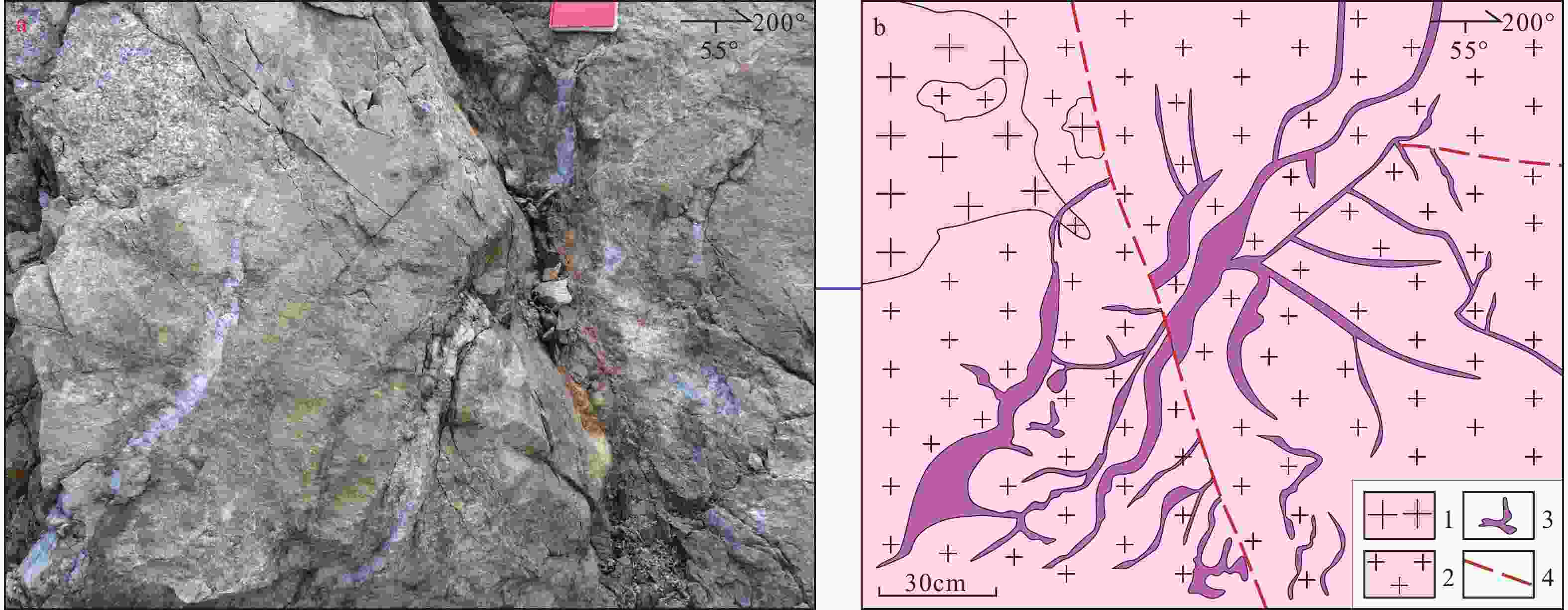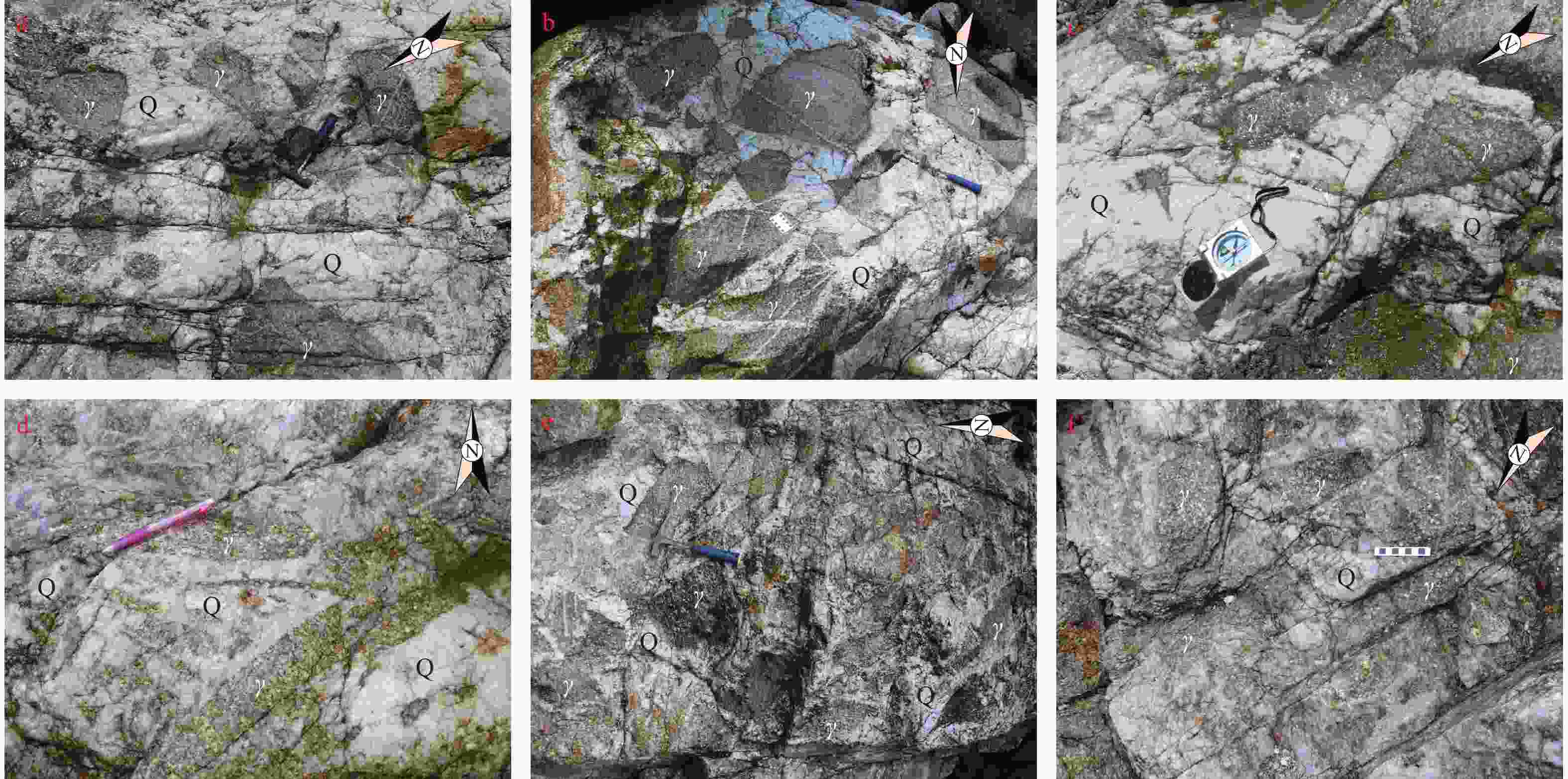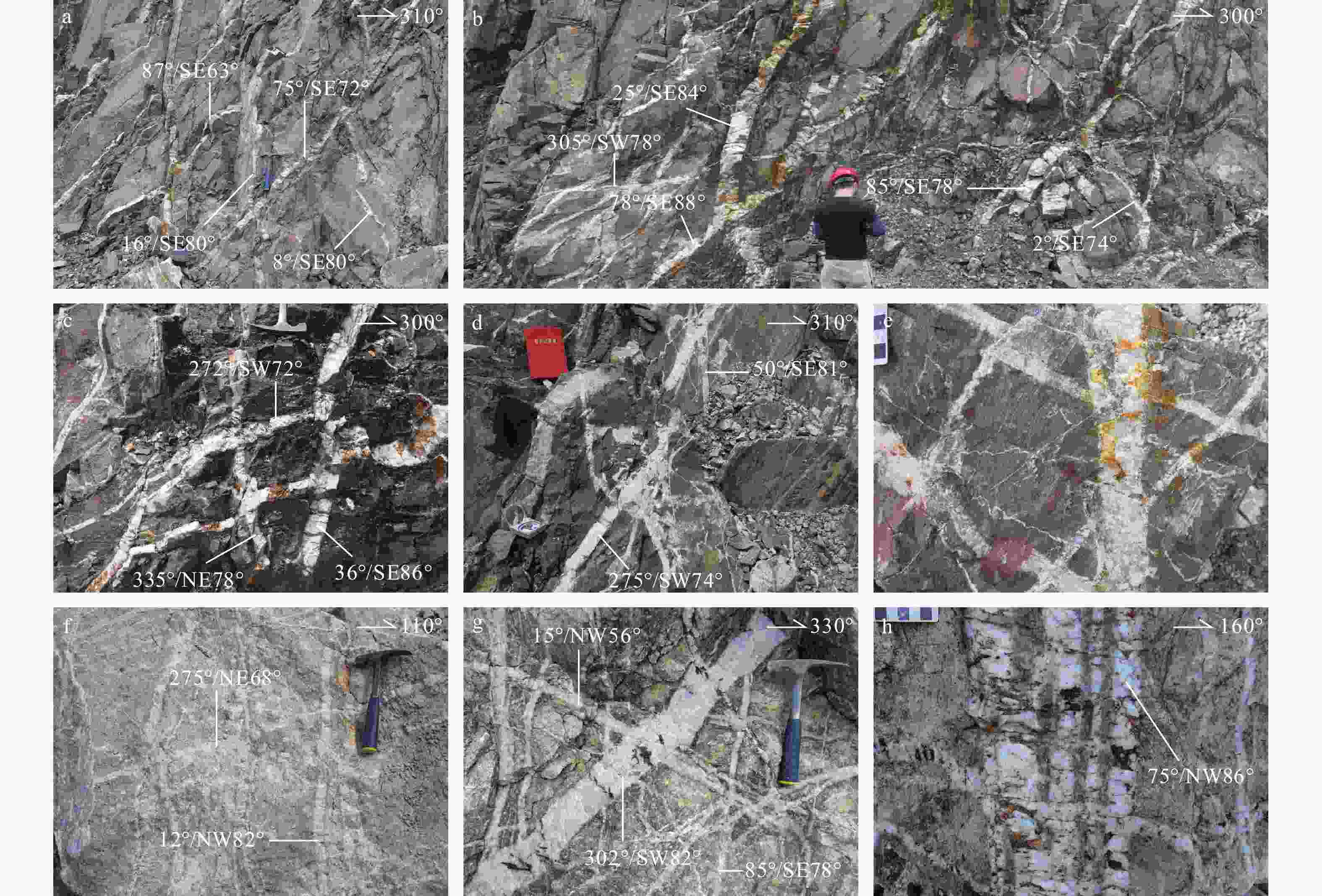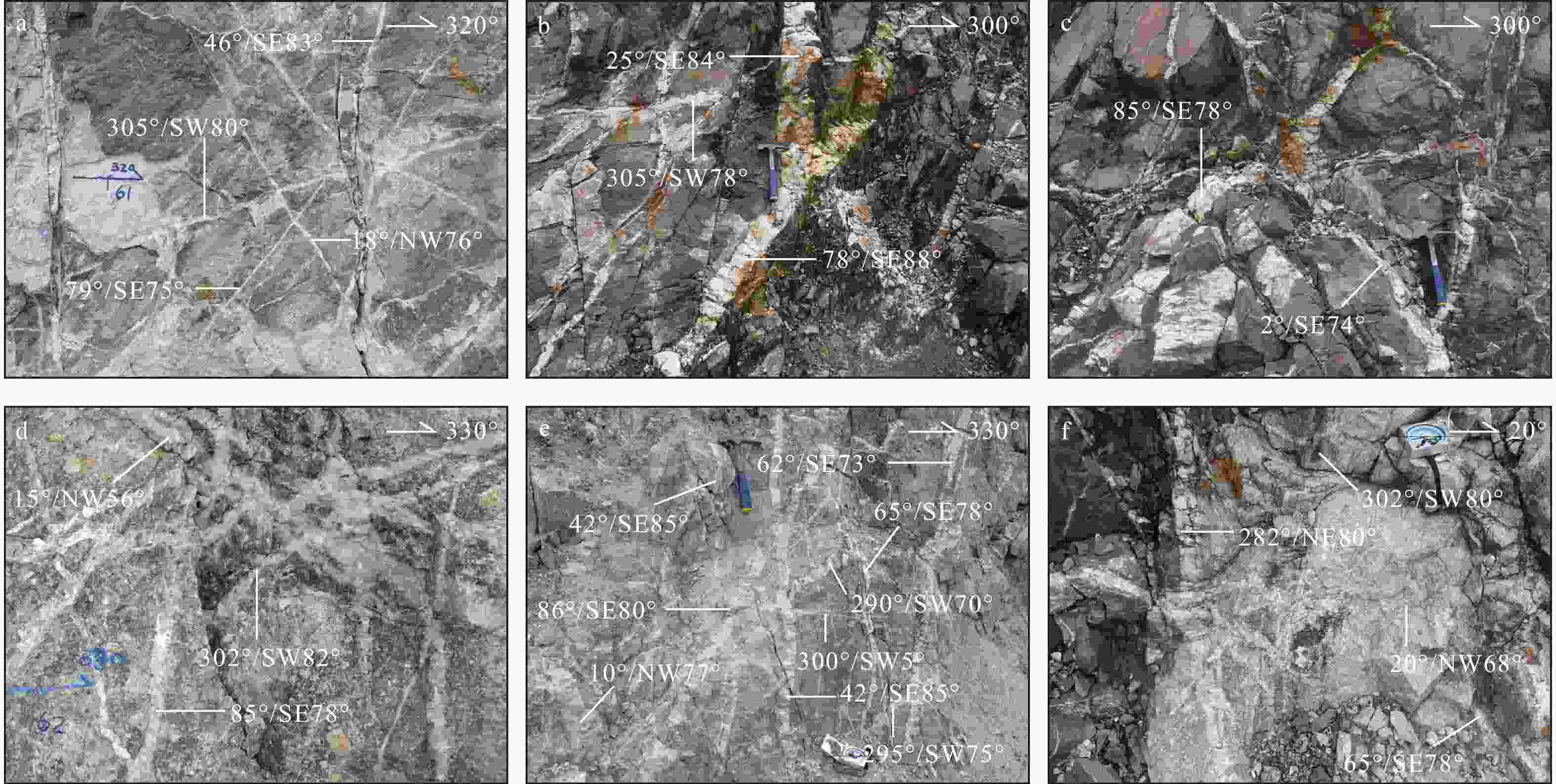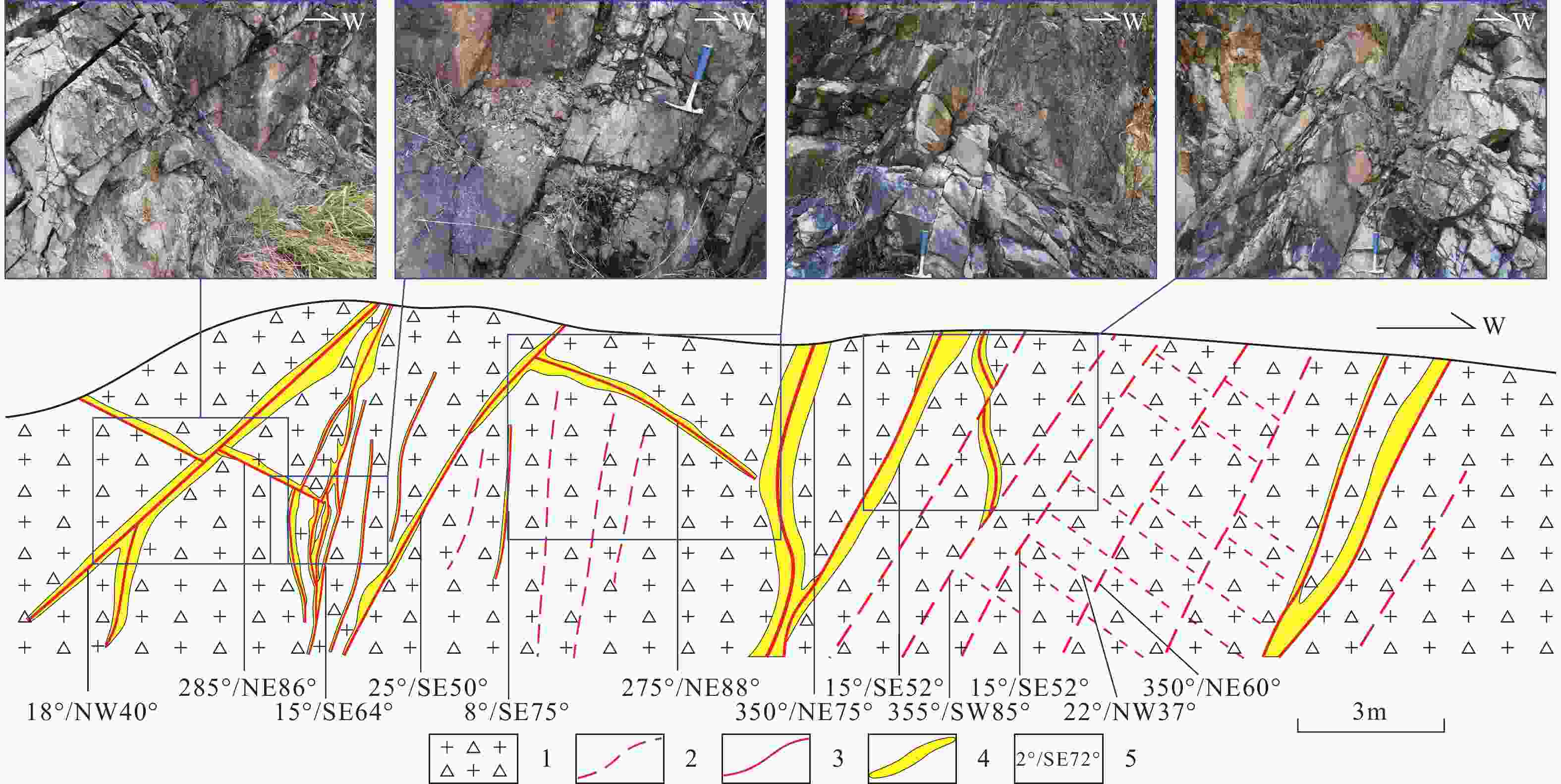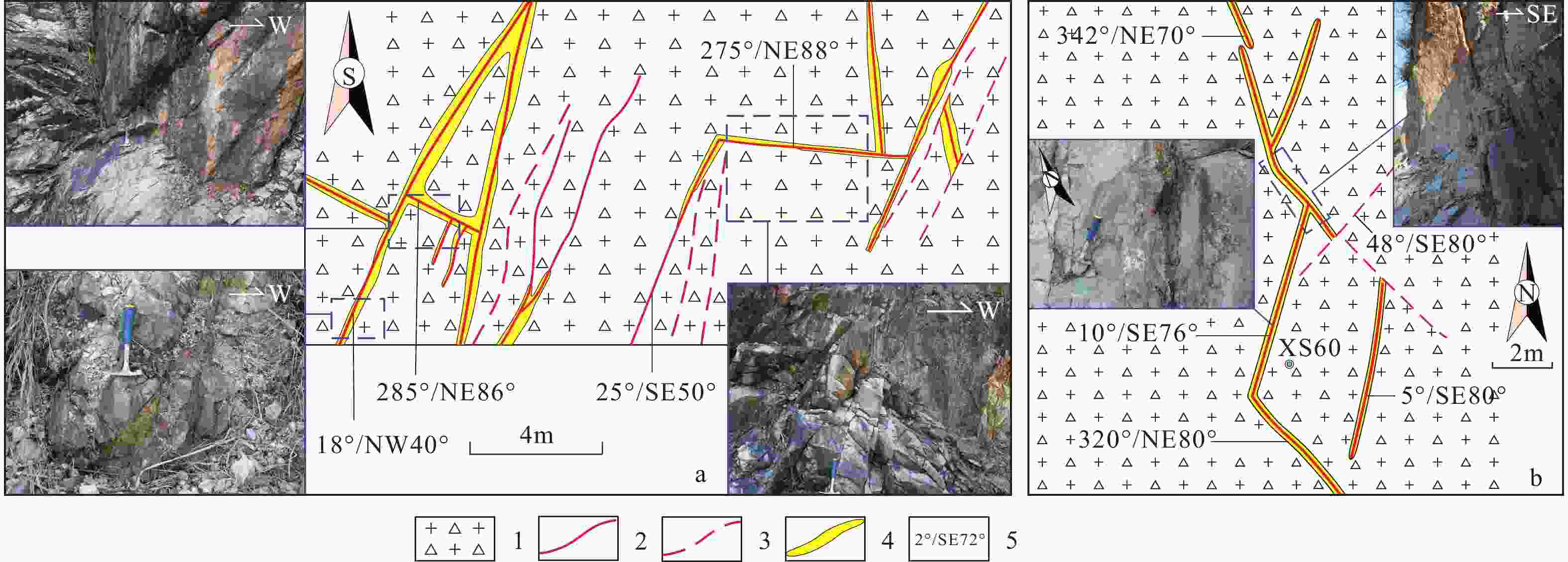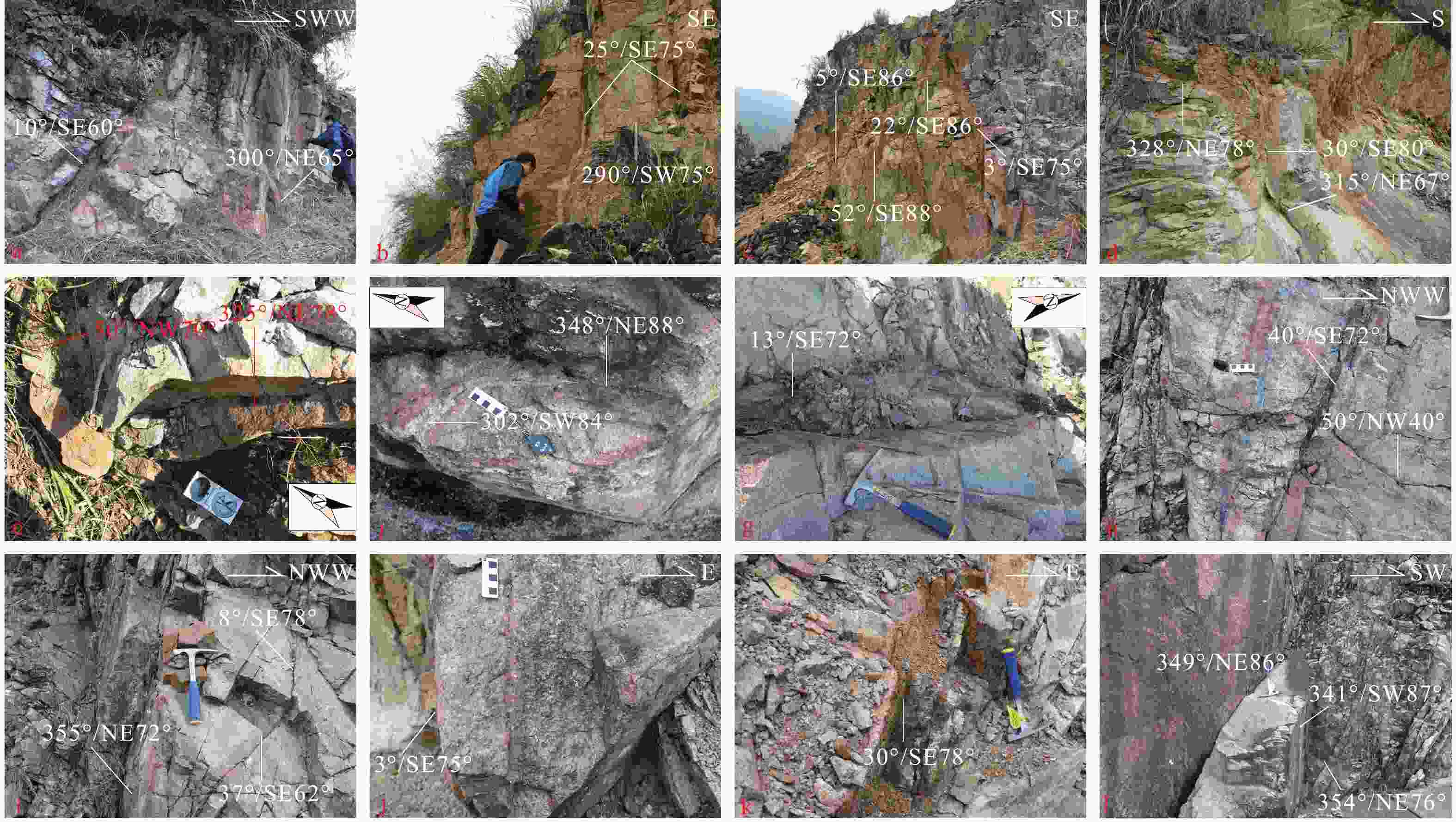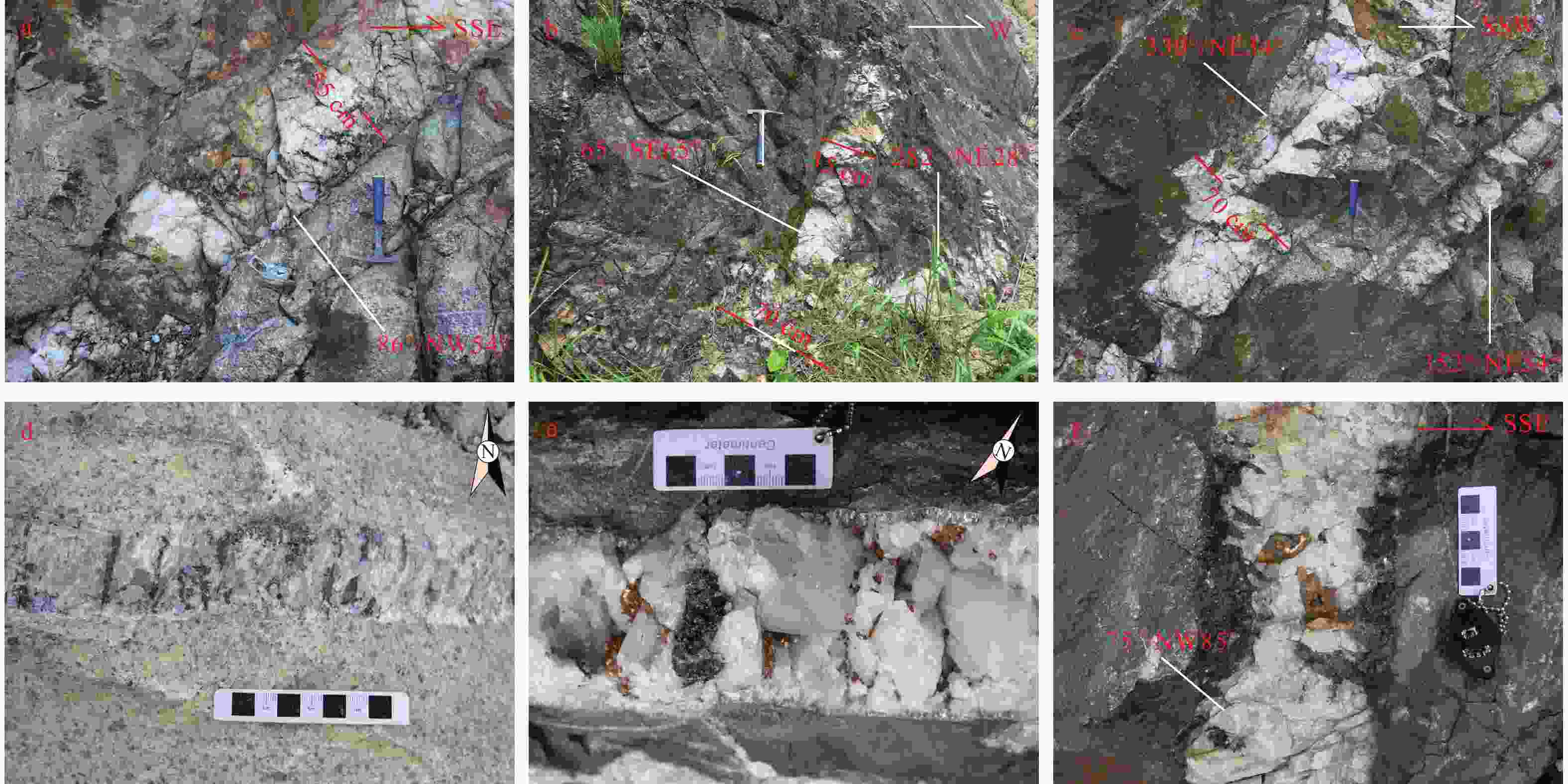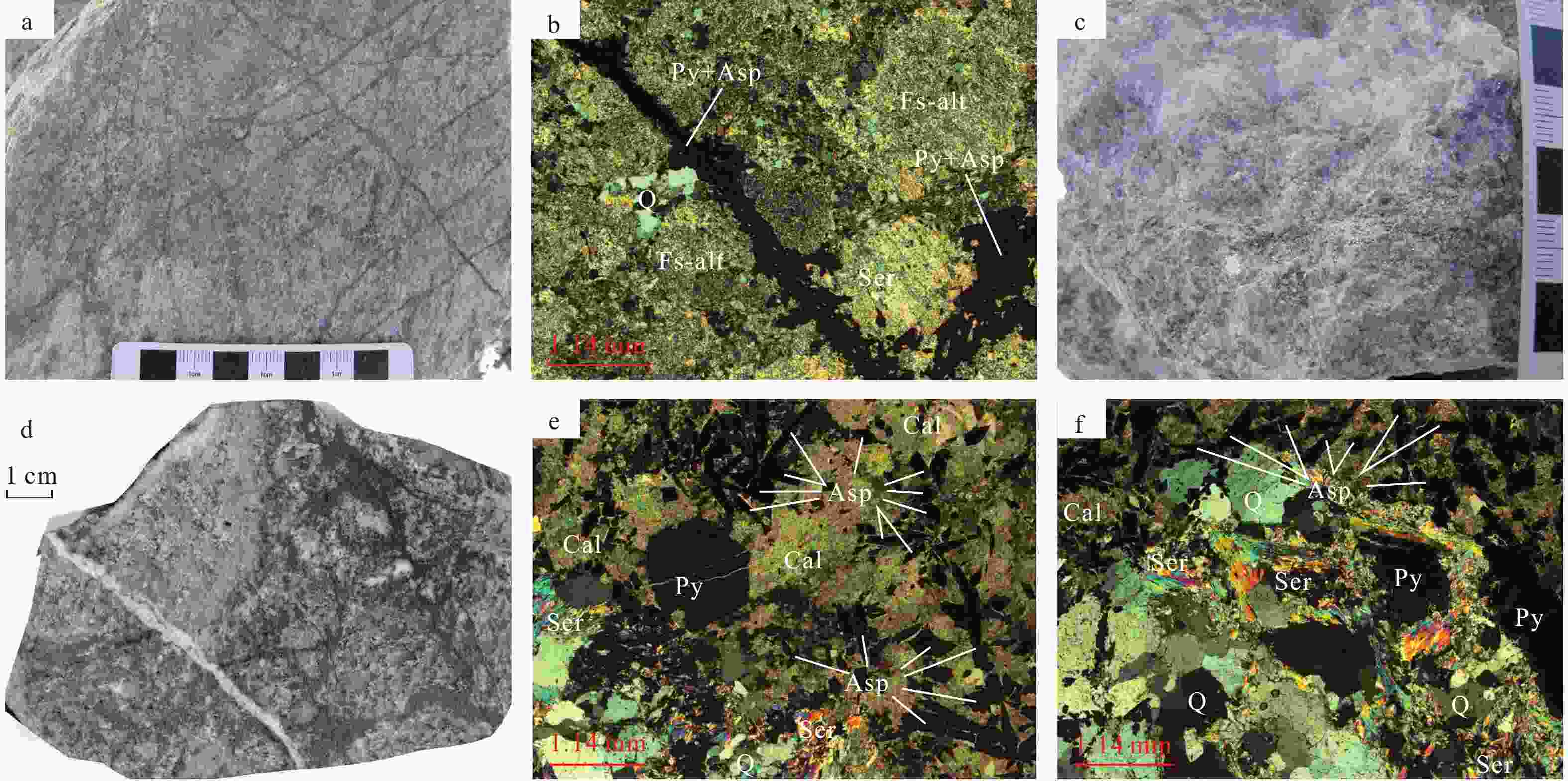Characteristics of hydraulic ore-bearing structure: A case study of hydrothermal tungsten and uranium deposits in South China
-
摘要: 液压致裂是整个地壳−岩石圈范围内一种重要的变形破裂方式,也是一些热液矿床的重要含矿构造。通过分析液压致裂构造的形成机制和液压成因含矿构造的类型(液压致裂型和液压撑开型),以华南地区典型热液钨、铀矿为例,基于野外精细调查,明确了包括石门寺钨矿、行洛坑钨矿和邹家山铀矿等的液压成因含矿构造的基本特征。新生性液压致裂含矿构造的主要特征表现为形态复杂(有弧形、分叉树枝形、放射状、菊花形和蟹腿状等)、规模较小、宏观力学性质以张性破裂为主、走向和倾向多变、方向性不明显、仅局部区域发育优势方位、常伴生有热液隐爆角砾岩;因此,可以从弧形分叉或不规则形态、总体较小规模、产状多向性、分布不均匀性和伴生热液隐爆角砾岩这5个标志来识别液压致裂含矿构造。对比分析液压致裂含矿构造与应力致裂含矿构造的差异认为,液压致裂含矿构造发育比较局限,而液压撑开型含矿构造相对普遍,热液蚀变分带与该含矿构造是液压致裂还是应力致裂无明显相关性;压性成因构造在成矿期表现出的张性力学性质有些是成矿流体超压作用的结果,而并非区域构造应力场的改变;液压致裂导致的断裂末端的扩展破裂与成矿流体的耦合作用为成矿末端效应的构造控制机制。Abstract:
Objective Hydraulic fracturing is a vital deformation and fracture mode in the whole crust-lithosphere range. The related structures are also critical ore-bearing structures of some hydrothermal deposits. Clarifying the main characteristics and identification marks of hydraulic fracturing ore-bearing structures aids in conducting detailed structural analyses of ore fields. Methods The article introduces the formation mechanism of hydraulic fracturing structures and classifies the hydraulic ore-bearing structures into two types, namely, hydraulic fracturing and hydraulic spreading. Taking typical hydrothermal tungsten and uranium deposits in South China as examples, the study, based on detailed field investigations, analyzes the essential characteristics of hydraulic fracturing ore-bearing structures, including the Shimensi tungsten deposit, Xingluokeng tungsten deposit and Zoujiashan uranium deposit. Results The study suggests that hydraulic fracturing ore-bearing structures are characterized by complex shapes (arc-shaped, branched, radial, chrysanthemum-shaped, etc.), relatively small scale, predominantly tensional macro-mechanical properties, variable trends and dips, indistinct directionality with dominant orientations in only local areas, and often accompanied by hydrothermal crypto-explosive breccia. Meanwhile, five typical marks of the hydraulically fractured ore-bearing structures have been identified, including arc bifurcation or irregular shape, overall small scale, multi-directional occurrence, uneven distribution, and associated hydrothermal crypto-explosive breccia. Conclusion After comparing and analyzing the similarities and differences between hydraulic fracturing ore-bearing structures and stress-induced ore-bearing fracturing, the study concludes that hydraulic fracturing ore-bearing structures are relatively limited in development. In contrast, hydraulic spreading fracturing ore-bearing structures are relatively common. There is no apparent correlation between the hydrothermal alteration zoning and whether the ore-bearing structure is due to hydraulic fracturing or stress-induced fracturing. Tensional structural features exhibited by compressional genesis structures during the mineralization period are attributed to overpressure from mineralizing fluids rather than changes in regional tectonic stress fields. Although the ore-bearing structures of compressive origin show tensional macro-mechanical properties during the metallogenic period, some result from the overpressure of ore-forming fluids rather than the change in the regional tectonic stress field. [ Significance ] As an important ore-bearing structure type, hydraulic fracturing enriches the connotation of ore field structure. The coupling effect between the extensional fracturing of fracture ends caused by hydraulic fracturing and ore-forming fluids is an essential mechanism of structural control of the ore-forming end effect, which will enhance the theory of structural ore control and contribute to breakthroughs in prospecting strategies. -
图 1 成矿流体压力随时间变化示意图(据Sibson,1990修改)
Pr—静岩负载(静岩压力+最小主应力+岩石内聚力最薄弱处的抗破裂强度);Pw—静水压力
Figure 1. Variation curve of ore-forming fluid pressure (P) with time (T) in fault valve model(modified after Sibson, 1990) Pr–Lithostatic load (lithostatic pressure + minimum principal stress + fracture strength at the weakest point of rock cohesion); Pw –Hydrostatic pressure
图 3 赣西北大湖塘矿田石门寺钨矿床不同产状含钨石英脉的同期贯入充填结晶特征
a—北西西向北缓倾与北东向近直立含钨石英脉同期充填结晶,矿区中部,平面照片;b—东西向与北东向近直立含钨石英脉同期充填结晶,矿区中部,平面照片;c—北北东向不同倾角含钨石英脉同期充填结晶,矿区东部,剖面照片;d—近东西向南倾与北倾含钨石英脉同期充填结晶,矿区中部,剖面照片;e—北北西向缓倾与北东东向陡倾含钨石英脉同期充填结晶,矿区北部,剖面照片;f—北东东向南倾与北倾含钨石英细脉同期充填结晶,矿区北部,剖面照片;g—北西西向北倾与北东向南倾含钨石英细脉同期充填结晶,矿区东部,剖面照片;h—北北西向东倾与北西西向缓倾含钨石英细脉同期充填结晶,矿区东部,剖面照片
Figure 3. Photos showing the contemporaneous filling-crystallization characteristics of tungsten-bearing quartz veins with different occurrence in the Shimensi tungsten deposit, Dahutang tungsten ore field, Northwestern Jiangxi
(a) NWW-trending tungsten-bearing quartz vein dipping to the north with low dipping angle and NE-trending upright tungsten-bearing quartz vein contemporaneously filled with crystallization, central mining area, plane photo; (b) EW-trending and NE-trending upright tungsten-bearing quartz veins contemporaneously filled with crystallization, central mining area, plane photo; (c) NNE-trending tungsten-bearing quartz veins with different dip angles contemporaneously filled with crystallization, eastern part of the mining area, profile photo; (d) Nearly EW-trending tungsten-bearing quartz veins dipping to the south and north contemporaneously filled with crystallization, central mining area, profile photo; (e) NNW-trending tungsten-bearing quartz veins with low dip angle and NEE-trending upright tungsten-bearing quartz veins contemporaneously filled with crystallization, in northern part of the mining area, profile photo; (f) NEE-trending tungsten-bearing quartz veinlets dipping to south and north contemporaneously filled with crystallization, northern part of the mining area, profile photo; (g) NWW-trending tungsten-bearing quartz veinlets dipping to north and NE-trending tungsten-bearing quartz veinlets dipping to south contemporaneously filled with crystallization, eastern part of the mining area, profile photo; (h) NNW-trending and NWW-trending with low dipping angle tungsten-bearing quartz veinlets contemporaneously filled with crystallization, easternern part of the mining area, profile photo
图 4 石门寺钨矿床露天采场中部出露的多组产状含钨石英脉赋存特征
①—⑦—石英脉编号;A—C—露头自然临空面编号a—多组含矿裂隙面野外特征;b—多组含矿裂隙面三维展布
Figure 4. Picture and sketch showing the multidirectional tungsten-bearing quartz veins exposed at the same position in the central part of open pit in the Shimensi tungsten deposit
(a) Photo of multiple groups of ore-bearing fracture surfaces; (b) Spatial distribution of multiple groups of ore-bearing fracture surfaces ① to ⑦ are quartz vein numbers ; A to C represent outcrop natural exposure surface.
图 5 石门寺钨矿床露天采场中部含钨石英脉呈树枝状、菊花状形态
1—粗粒黑云母花岗岩;2—细粒二云母花岗岩;3—含钨石英脉;4—晚期断层a—含钨石英脉野外特征;b—含钨石英脉素描图
Figure 5. Picture and sketch showing the crab-leg-like or chrysanthemum-shaped tungsten-bearing quartz veins in the central part of the pit in the Shimensi tungsten deposit of the Dahutang tungsten ore field, Jiangxi province
(a) Field characteristics of tungsten-bearing quartz veins; (b) Sketch of tungsten-bearing quartz veins 1–coarse-grained biotite granite; 2–fine-grained muscovite granite; 3–tungsten-bearing quartz vein
图 6 石门寺钨矿床中部热液角砾岩发育特征
γ—花岗岩;Q—石英脉a—c—热液隐爆角砾岩,角砾为燕山期花岗岩,含钨石英质为胶结物,花岗岩角砾总体呈棱角状,但尖角被熔蚀、具有近似可拼合特点,矿区中部,近水平面照片;d—f—含钨石英脉呈多方向、不规则状发育,倾角较陡,脉间花岗岩块体具有棱角状、近似可拼合特点,矿区中部,近水平面照片
Figure 6. Photos showing the hydrothermal cryptoexplosive breccia in the central part of the Shimensi tungsten deposit of Dahutang tungsten ore field, Jiangxi province
(a–c) Photo of hydrothermal crypto-explosive breccia; The breccia is Yanshanian granite which is cemented by tungsten-bearing quartz, and the granite breccia is generally angular, but the sharp corners are melted and eroded, which has the characteristics of approximate splicing (taken in the central part of the mining area and near the horizontal plane); (d–f) Photos showing tungsten-bearing quartz veins developed in multiple directions, irregularly with steep dip angle; The granite blocks between veins are angular and approximately splitable (taken at the central mining area and near the horizontal plane)γ–granite; Q–quartz vein
图 7 行洛坑钨矿床不同产状含钨石英脉具有同期贯入充填结晶特征
a—浅变质碎屑岩中发育近东西向和近北北东向较粗大石英脉钨矿体(厚约8~10cm)及少量其他方向石英细脉钨矿体,具有同期贯入充填特点,露天采场西南部;b、c—浅变质碎屑岩中发育近东西向和近南北向较粗大石英脉钨矿体(厚约8~10cm)及少量其他方向石英细脉钨矿体,具有同期贯入充填特点,露天采场西南部;d—浅变质碎屑岩中发育多组石英细脉钨矿体(厚约1~5cm),具有同期贯入充填特点,露天采场西南部;e—浅变质碎屑岩中发育3组石英细脉钨矿体(厚约1~5cm),具有同期贯入充填特点,矿石堆捡块样品照片;f—中—粗粒似斑状花岗岩中发育近东西向和近南北向石英细脉钨矿体(厚约3~5cm)及少量其他方向石英细脉钨矿体,具有同期贯入充填特点,露天采场南部;g—中—粗粒似斑状花岗岩中发育北西向粗大石英脉钨矿体(厚约15cm)与多方向石英细网脉钨矿体,具有同期贯入充填特点,露天采场近中心偏西南部;h—中粒钾长花岗岩中发育北东东向粗大石英脉钨矿体(厚约20cm)与其他方向石英细脉钨矿体,具有同期贯入充填特点,露天采场中部
Figure 7. Photos showing the contemporaneous filling-crystallization characteristics of W-bearing quartz veins with different occurrence in the Xingluokeng tungsten deposit, Fujian province
(a) Photograph showing the thick quartz vein-type tungsten bodies (about 8–10cm thick) with nearly EW-trending and NNE-trending, and a small number of quartz vein-type tungsten bodies in other directions in epimetamorphic clastic rock, exhibiting the characteristics of simultaneous penetration and filling, at the southwestern part of the open pit; (b, c) Photographs showing the thick quartz vein-type tungsten bodies (about 8–10cm thick) with nearly EW-trending and nearly SN-trending, and a few quartz vein-type tungsten bodies in other directions in epimetamorphic clastic rock, exhibiting the characteristics of simultaneous penetration and filling, at the southwestern part of the open pit; (d) Photograph showing several groups of quartz veinlet-type tungsten bodies (about 1–5cm thick) in the epimetamorphic clastic rocks, showing the characteristics of simultaneous penetration and filling, at the southwestern part of the open pit; (e) Photograph showing three groups of quartz veinlet tungsten-type ore bodies (about 1–5cm thick) in the epimetamorphic clastic rocks, which have the characteristics of simultaneous penetration and filling (The sample is collected in the ore heap); (f) Photograph showing the SN-trending and EW-trending quartz veinlets (about 3–5cm thick) and a few quartz veinlets in other directions in the medium-coarse porphyritic granite, with the characteristics of simultaneous penetration and filling, at the southern part of the open pit; (g) Photograph showing the thick NW-trending quartz vein-type tungsten bodies (about 15cm thick) and multidirectional quartz fine-mesh vein-type tungsten bodies in the medium-coarse-grained porphyritic granite, exhibiting the characteristics of simultaneous infiltration and filling, near the southwestern part of the open pit center; (h) Photograph showing the thick quartz vein-type tungsten body (about 20cm thick) with the NEE-trending and the quartz vein-type tungsten body in other directions in the medium-grained potassium feldspar granite, with the characteristics of simultaneous penetration and filling, at the central part of the open pit.
图 8 行洛坑钨矿床不同形态产状含钨石英脉及其同期贯入充填结晶特征
a—浅变质碎屑岩中发育近南北向、北西西向和近北东东向细石英脉钨矿体(厚约0.5~2cm),具有同期贯入充填特点,露天采场西南部;b—浅变质碎屑岩中发育近东西向和近南北向较粗大石英脉钨矿体(厚约8~10cm)及少量其他走向的石英细脉钨矿体,具有同期贯入充填特点,矿区露天采场西南部,图7b的局部放大;c—浅变质碎屑岩中发育近东西向和近南北向较粗大石英脉钨矿体(厚约8~10cm)及少量其他走向的石英细脉钨矿体,具有同期贯入充填特点,构成似放射状钨矿脉组合,露天采场西南部,图7b的局部放大;d—中—粗粒似斑状花岗岩中发育北东东、北北东和北西西向石英细网脉钨矿体(厚约1~3cm),具有同期贯入充填特点,露天采场近中心偏西南部;e—中粗粒似斑状花岗岩中发育北东、北北东、北西和近东西向石英细网脉钨矿体,具有同期贯入充填特点,露天采场近中心偏西部;f—中—粗粒似斑状花岗岩中发育近北东东、北北东、北西西和北西向石英细脉钨矿体(厚约3~5cm),具有同期贯入充填特点,露天采场西南部
Figure 8. Photos showing tungsten-bearing quartz veins with different occurrences and shapes in the Xingluokeng tungsten deposit, Fujian province and their simultaneous filling-crystallization characteristics
(a) Photograph showing nearly SN-trending, NWW-trending and NEE-trending fine quartz vein-type tungsten bodies (about 0.5–2cm thick) in the epimetamorphic clastic rocks at the southwestern part of the open pit, exhibiting characteristics of simultaneous penetration and filling; (b) Photograph showing the thick quartz vein-type tungsten bodies (about 8–10cm thick) in the nearly EW direction and nearly SN direction, along with a small number of quartz vein-type tungsten bodies in other directions at the southwestern part of the open pit, exhibiting characteristics of simultaneous penetration and filling; It's a partial enlargement of Fig.7b; (c) Photograph showing the thick quartz vein-type tungsten bodies (about 8–10cm thick) in the nearly EW direction and nearly SN direction in the epimetamorphic clastic rocks, along with a small number of quartz vein-type tungsten bodies in other directions at the southwestern part of the open pit, showing characteristics of simultaneous penetration and filling, forming a radial tungsten vein combination; It's a partial enlargement of Fig.7b; (d) Photograph showing the NEE-trending, NNE-trending and NWW-trending quartz veinlets tungsten bodies (about 3–5cm thick) in the medium-coarse porphyritic granite at the southwestern part near the center of the open pit, with the characteristics of simultaneous penetration and filling; (e) Photograph showing the NE-trending, NNE-trending, NW-trending and nearly EW-trending quartz veinlets tungsten bodies (about 3–5cm thick) in the medium-coarse porphyritic granite at the western part near the center of the open pit, with the characteristics of simultaneous penetration and filling; (f) Photograph showing the NEE-trending, NNE-trending, NWW-trending and NW-trending quartz veinlets tungsten bodies (about 3–5cm thick) in the medium-coarse porphyritic granite at the southwestern part of the open pit, with the characteristics of simultaneous penetration and filling.
图 9 邹家山铀矿床露天采场中段南缘铀矿体及含矿裂隙展布(剖面)图
1—碎斑熔岩;2—无矿裂隙;3—含矿裂隙;4—铀矿体;5—产状(走向/倾向倾角)
Figure 9. Picture and sketch showing the distribution of ore-bearing fractures and ore-bodies at the south edge of central part of the open pit, Zoujiashan uranium deposit (section) 1–brecciated lava; 2–non-mineralized fractures; 3–mineralized fractures; 4–uranium ore bodies; 5–occurrences (strike/dip and dip angle)
图 10 邹家山铀矿床露天采场中铀矿体及含矿裂隙展布(平面)图
1—碎斑熔岩;2—含矿裂隙;3—无矿裂隙;4—铀矿体;5—产状(走向/倾向倾角)a—露天采场中部南缘;b—露天采场北部东缘
Figure 10. Picture and sketch showing the distribution of ore-bearing fractures and ore-bodies in the open pit mining, Zoujiashan uranium deposit (plane)
(a) The south edge of central part of the open pit; (b) The east edge of nouthern part of the open pit 1–porphyroclastic lava; 2–non-mineralized fractures; 3–mineralized fractures; 4–uranium ore bodies; 5–occurrences (strike/dip and dip angle)
图 11 江西相山铀矿田邹家山铀矿床地表采场含矿裂隙特征
a—含矿裂隙呈弧形延伸,包裹有透镜状岩块,露天采场中部;b—含矿裂隙呈北北东向和北西西向分支复合延伸,露天采场北端;c—含矿裂隙呈北北东向和北东向分支复合延伸,露天采场北端;d—含矿裂隙呈北东向和北西向分支复合延伸,露天采场北部东缘;e—含矿裂隙由北西走向转向北东走向,露天采场北部东缘;f—铀矿化沿透镜体包络裂隙发育,反映矿化时成矿流体压力较大,采场中南部东缘;g—铀矿化沿弧形裂隙及碎裂透镜体岩块发育,形成透镜状铀矿体,中南部的东缘;h—铀矿化沿主裂隙旁侧不规则微裂隙发育,露天采场中北部的东南缘;i—铀矿化沿主裂隙发育,并形成不规则新生微裂隙且矿化,图11h的局部放大,露天采场中北部的东南缘;j—铀矿化沿南北向微裂隙发育,露天采场北端;k—铀矿化沿南北向微裂隙发育,露天采场北端;l—矿化沿先期裂隙发育,局部形成新裂隙,反映成矿流体压力大,露天采场南部东缘
Figure 11. Pictures showing the characteristics of ore-bearing fractures in the open pit mining of the Zoujiashan uranium deposit, Xiangshan uranium ore field, Jiangxi province
(a) Ore-beaing fractures extend in an arc shape, enveloping lenticular rocks; central part of the open pit; (b) Ore-beaing fractures extend in NNE direction and NWW direction; north end of the open pit; (c) Ore-bearing fractures extend in NNE direction and NE direction, north end of the open pit; (d) Ore-bearing fractures extend in NE direction and NW direction; east edge of the north part of the open pit; (e) Ore-bearing fractures turn from NW-strike to NE-strike; east edge of north part of the open pit; (f) Uranium mineralization develops along the margin of the lenticular rock, indicating a high pressure of the ore-formation fluid; east edge of the south-central part of the open pit; (g) Uranium mineralization develops along arcuate and cataclastic lenticular rocks, forming lenticular uranium ore bodies; east edge of the south-central part of the open pit; (h) Uranium mineralization develops along micro irregular fractures beside main fractures; southeast edge of the north-central part of the open pit; (i) Uranium mineralization develops along main fractures, forming several micro irregular fractures with mineralization; southeast edge of the north-central part of the open pit; It's a partial enlargement of Fig.11h;(j) Uranium mineralization develops along SN-trending microfissures; north end of the open pit; (k) Uranium mineralization develops along SN-trending microfissures; north end of the open pit; (l) Uranium mineralization along pre-existing fractures, locally forming several new micro fractures with mineralization, reflecting high pressure of ore-formation fluids; east edge of the southern part of the open pit.
图 12 相山铀矿田部分矿床的矿体形态及分布图(张万良等,2015)
1—下白垩统鹅湖岭组第2岩性段;2—下白垩统打鼓顶组第2岩性段;3—铀矿体;4—微细铀矿脉;5—坑道;6—勘探线a—邹家山铀矿床−170 m中段;b—沙洲铀矿床−58 m中段
Figure 12. Morphology and distribution map of ore bodies in some deposits of the Xiangshan uranium ore field(Zhang et al, 2015)
(a) −170 m section of the Zoujiahsna uranium deposit; (b) −58m section of the Shazhou uranium deposit 1–the second member of the Ehuling Formation of Lower Cretaceous; 2–the second member of the Daguding Formation of Lower Cretaceous; 3–uranium ore bodies; 4–uranium veinlets; 5–tunnels; 6–exploration lines
图 13 液压致裂含矿构造控制的高温热液型钨矿床的矿脉结晶特点
a—花岗岩中近东西向石英大脉型钨矿体,厚度约55 cm,石英晶体较大,晶形好,局部有晶洞,石门寺钨矿床露天采场东部;b—花岗岩中近东西走向、不同倾向、中—缓倾角的石英大脉型钨矿体,最宽约70 cm,石门寺钨矿床东南缘;c—花岗岩中北北西向石英大脉型钨矿体,厚度大,约70 cm,石门寺钨矿床东缘;d—花岗岩中含钨石英脉,厚度约7 cm,石英、黑钨矿及少量方解石矿物晶体大,晶形好,对壁生长,梳状构造,行洛坑钨矿床露天采场中部708平台;e—浅变质碎屑岩中发育北东东向石英大脉型钨矿体,厚度约6 cm,石英、黑钨矿及少量铁白云石矿物晶体大,晶形好,对壁生长,梳状构造,行洛坑钨矿床露天采场南部708中段;f—浅变质碎屑岩中发育北东东向石英大脉型钨矿体,厚度约10cm,石英、黑钨矿及少量铁白云石矿物晶体大,晶形好,对壁生长,梳状构造,行洛坑钨矿床露天采场南部708中段
Figure 13. Pictures showing the characteristics of vein crystallization in high-temperature hydrothermal tungsten deposits controlled by hydraulic fracturing ore-bearing structure
(a) Photograph showing an about 55 cm wide quartz vein-type tungsten ore body in the granite, with large quartz crystals, good crystal form and local caverns; eastern part of the open pit of the Shimensi tungsten deposit; (b) Photograph showing a quartz vein-type tungsten ore body with nearly EW-strike, different dips and moderate–gentle dip angles in the granite, with the maximum width of about 70cm, at the southeast edge of the Shimensi tungsten deposit; (c) Photograph showing an about 70 cm wide NNW-trending quartz vein-type tungsten ore body in the granite, at the east edge of the Shimensi tungsten deposit; (d) Photograph showing an about 7 cm wide tungsten-bearing quartz vein-type ore in the granite, with quartz, wolframite and a little calcite minerals having large crystals, good crystal shapes, opposite-wall growth, comb structures, at the middle part of the open pit on the platform 708 of the Xingluokeng tungsten deposit; (e) Photograph showing an about 6 cm thick NEE-trending quartz vein-type tungsten ore body developed in shallow metamorphic clastic rocks, with quartz, wolframite and a little of ankerite minerals having large crystals, good crystal shapes, opposite-wall growths and comb-like structures, at the southern part of the open pit on the platform 708 of the Xingluokeng tungsten deposit; (f) Photograph showing an about 10cm thick quartz vein-type tungsten body, with quartz, wolframite and a little of ankerite minerals having large crystals, good crystal shapes, opposite-wall growths and comb-like structures, at the southern part of the open pit on the platform 708 of the Xingluokeng tungsten deposit.
图 14 青海五龙沟金矿床受液压致裂构造控制的金矿石特征
Q—石英;Fs-alt—蚀变长石;Py—黄铁矿;Asp—毒砂;Cal—方解石;Ser—绢云母a—含细−网脉硫化物蚀变岩型金矿石,原岩为黑云斜长片麻岩,整体发生强蚀变,之后形成微裂隙,沿微裂隙发育黄铁矿、毒砂微脉,红旗沟矿段VII号矿带;b—含细−网脉硫化物蚀变岩型金矿石,可见原岩黑云母斜长片麻岩发生较强绢云母化,沿微裂隙发育黄铁矿和毒砂,图14a的正交偏光显微照片;c—角砾状金矿石,角砾为强蚀变花岗质片麻岩,胶结物为含微细硫化物(黄铁矿、毒砂)的石英−方解石,岩金沟矿段III号矿带;d—角砾状富金矿石;角砾为蚀变花岗岩,角砾中可见浸染状黄铁矿和强绢云母化,胶结物为含微细粒状黄铁矿和微细针状毒砂的方解石−石英,岩金沟III号矿带;e、f—角砾状富金矿石,胶结物由石英和方解石、毒砂、黄铁矿组成,金属矿物呈自形晶,黄铁矿为粒状,毒砂为针状,金品位110g/t,岩金沟III号带,正交偏光显微照片
Figure 14. Characteristics of gold ore controlled by hydraulic fracturing structure in the Wulonggou gold deposit, Qinghai Province
(a) Photograph showing the altered rock-type gold ore containing fine-reticulate vein sulfide; The original rock is biotite plagioclase gneiss, which undergoes strong alteration leading to the formation of micro-cracks; Pyrite and arsenopyrite micro-veins develop along these micro-cracks; The position is on VII ore belt of the Hongqigou mine section; (b) Micrograph showing the altered rock-type gold ore containing fine-reticulate sulfide; The original rock is biotite plagioclase gneiss exhibiting strong sericitization, and pyrite and arsenopyrite develop along micro-cracks; It is a polarized light microscopic image of Fig.14a; (c) Photograph showing the breccia-like gold ore, where breccia is strongly altered granitic gneiss, and the cement is quartz-calcite containing fine sulfide (pyrite and arsenopyrite); The position is on III ore belt of the Yanjingou mine section; (d) Photograph showing the breccia-like gold-rich ore, where breccia is altered granite, exhibiting infiltration of pyrite and strong sericitization; The cement is calcite quartz containing fine granular pyrite and fine needle-like arsenopyrite; The position is on III ore belt of the Yanjingou mine section; (e, f) Polarized light microscopic images showing breccia-like gold-rich ore; The cement is composed of quartz and calcite, euhedral crystal granular pyrite, needle-shaped arsenopyrite; The gold grade is 110g/t; The position is on III ore zone of the Yanjingou mine section Q–quartz; Fs-alt–altered feldspar; Py–pyrite; Asp–arsenopyrite; Cal–calcite; Ser–sericite
表 1 液压致裂含矿构造与应力致裂含矿构造特征对比
Table 1. Comparison table of characteristics of hydraulic fracturing ore-bearing structure and stress-induced fracturing ore-bearing structure
类型 液压致裂构造 应力致裂构造 规模 一般比较小,露头尺度较多,大的几十米,少数达百米级以上 从微小到大型均有,最大数百米、甚至千米级 形态 形态复杂多变,多数呈不规则弧形、分叉树枝形、还有网格状、放射状、菊花状或蟹腿状 大多数为直线形,派生构造可呈分支复合、羽列,压性构造部分可呈弧形,张性构造常呈折线状、锯齿状等 产状 多方向性,一般没有优势方向 具有明显的优势方向,如果有多方向则是配套关系 展布 比较局限,往往仅发育于超压成矿流体的中心附近 在构造体系影响范围内广泛展布 力学性质 宏观上显示张性力学性质 张性、压性、扭性构造均有发育,且可以相互配套 角砾岩 热液隐爆角砾岩,胶结物为热液矿物 构造角砾岩(有压、张、扭之分),胶结物为岩石碎粉 成因 成矿流体超压 定向构造应力 与热液矿床关系 出露于热液矿床近中心局部 出现于整个热液矿床及更大区域 -
[1] BARCOS L, DÍAZ-AZPIROZ M, BALANYÁ J C, et al. , 2016. Analogue modelling of inclined, brittle-ductile transpression: Testing analytical models through natural shear zones (external Betics)[J]. Tectonophysics, 682: 169-185. doi: 10.1016/j.tecto.2016.05.021 [2] BONS P D, ELBURG M A, GOMEZ-RIVAS E, 2012. A review of the formation of tectonic veins and their microstructures[J]. Journal of Structural Geology, 43: 33-62. doi: 10.1016/j.jsg.2012.07.005 [3] BOULLIER A M, ROBERT F, 1992. Palaeoseismic events recorded in Archaean gold-quartz vein networks, Val d'Or, Abitibi, Quebec, Canada[J]. Journal of Structural Geology, 14(2): 161-179. doi: 10.1016/0191-8141(92)90054-Z [4] BYERLEE J, 1993. Model for episodic flow of high –pressure water in fault zones before earthquakes[J]. Geology, 21(4): 303-306. doi: 10.1130/0091-7613(1993)021<0303:MFEFOH>2.3.CO;2 [5] CHEN B L, 2020. Development process of fault structure and formation and evolution of ore-controlling structure: a case study of the Zoujiashan uranium deposit[J]. Journal of Geomechanics, 26(3): 285-298. (in Chinese with English abstract) [6] CHEN B L, GAO Y, SHEN J H, et al. , 2021a. Study on the ore-bearing fracture system of the Zoujiashan Uranium Deposit, Jiangxi, SE China[J]. Acta Geologica Sinica, 95(5): 1523-1544. (in Chinese with English abstract) [7] CHEN B L, GAO Y, SHEN J H, et al. , 2021b. Structural control of ore body location[R]. Beijing: Institute of Geomechanics, Chinese Academy of Geological Sciences. (in Chinese) [8] CHEN B L, GAO Y, SHEN J H, et al. , 2022. Analysis of Ore-controlling structure of Changjiang Uranium Ore Field, northern Guangdong[J]. Earth Science, 47(1): 159-177. (in Chinese with English abstract) [9] CHEN F E, LIU J Z, WANG Z P, et al. , 2020. Exploration research progress and deep prospecting prediction of Huijiabao gold ore field in Southwest Guizhou[J]. Guizhou Geology, 37(2): 115-123. (in Chinese with English abstract) [10] CHEN L Y, LI X J, BI J, et al. , 2019. Effect of proppant on pore structure in northern Guizhou shale during hydraulic fracturing[J]. Ming Tecknology, 19(4): 11-14. (in Chinese without English abstract) [11] CHEN Y C, WANG D H, XU Z G, et al. , 2014. Outline of regional metallogeny of ore deposits associated with the Mesozoic magmatism in South China[J]. Geotectonica et Metallogenia, 38(2): 219-229. (in Chinese with English abstract) [12] COX S F, 1995. Faulting processes at high fluid pressures: an example of fault valve behavior from the Wattle Gully Fault, Victoria, Australia[J]. Journal of Geophysical Research: Solid Earth, 100(B7): 12841-12859. doi: 10.1029/95JB00915 [13] DOOLEY T P, SCHREURS G, 2012. Analogue modelling of intraplate strike-slip tectonics: a review and new experimental results[J]. Tectonophysics, 574-575: 1-71. doi: 10.1016/j.tecto.2012.05.030 [14] DU J G, WU K T, SUN F X, et al. , 2022. Cryptoexplosive breccia: a genetic mark of the paleoearthquakes[J]. Acta Petrologica Sinica, 38(3): 913-922. (in Chinese with English abstract) doi: 10.18654/1000-0569/2022.03.18 [15] FAN H R, LAN T G, LI X H, et al. , 2021. Conditions and processes leading to large-scale gold deposition in the Jiaodong province, eastern China[J]. Science China Earth Sciences, 64(9): 1504-1523. (in Chinese with English abstract) doi: 10.1007/s11430-020-9789-2 [16] FANG W X, GUO Y Q, JIA R X, et al. , 2021. On relationship between the superimposed mineralization systems and the zoning patterns of vertical tectonic lithofacies in the Gejiu concentration area of Sn-Cu-W and three rare metals in Yunnan[J]. Journal of Geomechanics, 27(4): 557-584. (in Chinese with English abstract) [17] GAO Y, ZHOU Y L, 2017. Geological characteristics and formation process of the Baquan cryptoexplosive breccia-type uranium ore deposit in Xiangshan, Jiangxi[J]. East China Geology, 38(2): 126-131. (in Chinese with English abstract) [18] GRIFFITH A A, 1921. VI. The phenomena of rupture and flow in solids[J]. Philosophical Transactions of the Royal Society A: Mathematical, Physical and Engineering Sciences, 221(582-593): 163-198. [19] GRIGGS D, HANDIN J, 1960. Rock deformation[M]. New York: Geological Society of America: 193-226. [20] GUDEMANN R E, 1990. Introduction to rock machamcs[M]. WANG H R, WANG H S, trans. Beijing: Water Resources and Electric Power Press: 1-298. (in Chinese) [21] GUDMUNDSSON A, 1999. Fluid overpressure and stress drop in fault zones[J]. Geophysical Research Letters, 26(1): 115-118. doi: 10.1029/1998GL900228 [22] HU R Z, BI X W, PENG J T, et al. , 2007. Some problems concerning relationship between Mesozoic-Cenozoic lithospheric extension and uranium metallogenesis in South China[J]. Mineral Deposits, 26(2): 139-152. (in Chinese with English abstract) [23] HU R Z, BI X W, ZHOU M F, et al. , 2008. Uranium metallogenesis in South China and its relationship to crustal extension during the cretaceous to tertiary[J]. Economic Geology, 103(3): 583-598. doi: 10.2113/gsecongeo.103.3.583 [24] HUBBERT M H, RUBEY W W, 1959. Role of fluid pressure in mechanics of overthrust faulting[J]. Geological Society of America Bulletin, 70(2): 115-166. doi: 10.1130/0016-7606(1959)70[115:ROFPIM]2.0.CO;2 [25] JIA R X, FANG W X, 2022. The genesis and ore-controlling regularity of interbedded orebodies controlled by tectonics and lithofacies in Lutangba, Gejiu, Yunnan Province[J]. Journal of Geomechanics, 28(1): 67-77. (in Chinese with English abstract) [26] JIANG Y, ZHAO X L, LI L M, et al. , 2020. Neoproterozoic continental margin –arc magmatic activity of the Nanping-Ninghua Tectonic Belt, South China: implications for tectonic evolution of the Wuyi Orogenic Belt[J]. Geology in China, 47(4): 1010-1024. (in Chinese with English abstract) [27] KERRICH R, FENG R, 1992. Archean geodynamics and the Abitibi-Pontiac collision: implications for advection of fluids at transpressive collisional boundaries and the origin of giant quartz vein systems[J]. Earth-Science Reviews, 32(1-2): 33-60. doi: 10.1016/0012-8252(92)90011-H [28] LIANG G H, 2017. Preliminary study of the relationship between cryptoexplosion and ore-forming process from Wenchuan earthquake[J]. Acta Petrologica Sinica, 33(2): 326-338. (in Chinese with English abstract) [29] LIU L M, 2011. Fluid overpressure and rock fracturing caused by shallow intrusion and their constraints on hydrothermal mineralization[J]. Earth Science Frontiers, 18(5): 78-89. (in Chinese with English abstract) [30] LIU Q S, WEI L, LIU X W, et al. , 2017. A revised empirical method for predicting crack initiation based on Griffith strength criterion[J]. Chinese Journal of Rock Mechanics and Engineering, 36(7): 1561-1569. (in Chinese with English abstract) [31] LYU G X, KONG Q C, 1993. Geology of Linglong-Jiaojia-type gold deposit[M]. Beijing: Science Press: 1-260. (in Chinese) [32] LYU G X, CHEN J, LI X B, et al. , 1998. Studies on structural additional static pressure and the estimation on diagenetic depth of the coesite-bearing eclogite[J]. Chinese Science Bulletin, 43(24): 2590-2602. (in Chinese) doi: 10.1360/csb1998-43-24-2590 [33] LYU G X, 2019. Research on tectonic dynamo-petrogenesis and metallogenesis and tectonophysicochemistry[J]. Journal of Geomechanics, 25(5): 962-980. (in Chinese with English abstract) [34] MAO J W, LUO M C, XIE G Q, et al. , 2014. Basic Characteristics and new advances in research and exploration on porphyry copper deposits[J]. Acta Geologica Sinica, 88(12): 2153-2175. (in Chinese with English abstract) [35] MAO J W, WU S H, SONG S W, et al. , 2020. The World-class Jiangnan Tungsten Belt: geological characteristics, Metallogeny, and Ore Deposit Model[J]. Chinese Science Bulletin, 65(33): 3746-3762. (in Chinese with English abstract) doi: 10.1360/TB-2020-0370 [36] NAYLOR M A, MANDL G, SUPESTEIJN C H K, 1986. Fault geometries in basement-induced wrench faulting under different initial stress states[J]. Journal of Structural Geology, 8(7): 737-752. doi: 10.1016/0191-8141(86)90022-2 [37] PHILLIPS W J, 1972. Hydraulic fracturing and mineralization[J]. Journal of the Geological Society, 128(4): 337-359. doi: 10.1144/gsjgs.128.4.0337 [38] RICHARD P D, NAYLOR M A, KOOPMAN A, 1995. Experimental models of strike-slip tectonics[J]. Petroleum Geoscience, 1(1): 71-80. doi: 10.1144/petgeo.1.1.71 [39] SIBSON R H, ROBERT F, POULSEN K H, 1988. High-angle reverse faults, fluid-pressure cycling, and mesothermal gold-quartz deposits[J]. Geology, 16(6): 551-555. doi: 10.1130/0091-7613(1988)016<0551:HARFFP>2.3.CO;2 [40] SIBSON R H, 1990. Fault structure and mechanics in relation to greenstone gold deposits[M]//ROBERT F, SHEAHAN P A, GREEN S B. Greenstone gold and crustal evolution, NUNA conference volume. Geological Association of Canada, 54-60. [41] SLEEP N H, BLANPIED M L, 1992. Creep, compaction and the weak rheology of major faults[J]. Nature, 359(6397): 687-692. doi: 10.1038/359687a0 [42] TONG H M, WANG J J, ZHAO H T, et al. , 2014. Mohr space and its application to the activation prediction of pre-existing weakness[J]. Science China: Earth Sciences, 57(7): 1595-1604. (in Chinese with English abstract) doi: 10.1007/s11430-014-4860-1 [43] WANG H, FENG C Y, LI R X, et al. , 2021. Ore-forming mechanism and fluid evolution processes of the Xingluokeng tungsten deposit, western Fujian Province: constraints form in-situ trace elemental and Sr isotopic analyses of scheelite[J]. Acta Petrologica Sinica, 37(3): 698-716. (in Chinese with English abstract) doi: 10.18654/1000-0569/2021.03.04 [44] WANG J C, WEI L M, ZHU W F, et al. , 2008. Texture and tectonic style of “Five-storeyed Type” for the tungsten deposits in the Nanling Mountains, southern China: an example from the Meiziwo tungsten deposit[J]. Acta Geologica Sinica, 82(7): 894-899. (in Chinese with English abstract) [45] WANG L, WANG L, LIAO Q M, 2012. Summary and application of occurrence law of branch orebodies with low grade and small scale in Shazhou Mine[C]//Essay collection of the academic research conference on the construction of national uranium base. Haikou: Chinese Nuclear Society: 1227-1231. (in Chinese) [46] WANG Y M, CHENG D, DONG J B, 1997. Influence of thermodynamic factors with temperature change during magma rising process[J]. Journal of Geology & Mineral Resources in North China, 12(2): 114-121. (in Chinese with English abstract) [47] WANG Z Y, ZHAO X L, YU S Y, et al. , 2020. Cretaceous granitic intrusions in Fujian Province, Cathaysia Block: implications for slab rollback and break-off of the Paleo-Pacific plate[J]. Journal of Asian Earth Sciences, 190: 104164. doi: 10.1016/j.jseaes.2019.104164 [48] WU G G and LYU C X. 2011. Research history, present situation and development of ore field structure study[J]. Geological Bulletin of China, 30(4): 461-468 (in Chinese with English abstract) [49] WU Y F, LI S J, ZHOU Y H, HUANG Z and FAN T. 2023. Study on the fracture characteristics of sandstone and the effect of grouting reinforcement under different confining pressure[J]. Chinese Journal of Underground Space and Engineering, 19(2): 80-90 (in Chinese with English abstract). [50] XIA Y L, 2019. Geochronology of uranium mineralization in China[M]. Beijing: China Atomic Energy Press: 1-301. (in Chinese) [51] XIANG X K, Liu X M, ZHAN G N, 2012. Discovery of Shimensi super-large tungsten deposit and its prospecting significance in Dahutang area, Jiangxi Province[J]. Resources Survey & Environment, 33(3): 141-151. (in Chinese with English abstract) [52] XIANG X K, WANG P, ZHAN G N, et al. , 2013. Geological characteristics of Shimensi Tungsten Polymetallic Deposit in northern Jiangxi province[J]. Mineral Deposits, 32(6): 1171-1187. (in Chinese with English abstract) [53] YU X D, XU L, LIU C M, et al. , 1994. A preliminary research on fluid fracturing mechanism on Xiaoqinling deposits[J]. Henan Geology, 12(1): 1-4. (in Chinese with English abstract) [54] YU X F, LI D P, SHAN W, et al. , 2022. Yanshanian gold metallogenic system and metallogenic model of the Guilaizhuang gold ore field, western Shandong[J]. Journal of Geomechanics, 28(5): 821-841. (in Chinese with English abstract) [55] ZHAI Y S, LIN X D, 1993. Structural geology in ore field[M]. Beijing: Geological Publishing House: 1-214. (in Chinese) [56] ZHANG J J, CHEN Z H, WANG D H, et al. , 2008. Geological characteristics and metallogenic epoch of the Xingluokeng tungsten deposit, Fujian Province[J]. Geotectonica et Metallogenia, 32(1): 92-97. (in Chinese with English abstract) [57] ZHANG T F, PAN X F, YANG D, et al. , 2015. Fluid evolution of the alteration-mineralization system in the Zhushahong copper-gold porphyry deposit, Dexing, Jiangxi Province: constraint from H-O isotopes[J]. Acta Petrologica et Mineralogica, 34(4): 505-516. (in Chinese with English abstract) [58] ZHANG W L, LI Z Y, 2005. Metallogenetic characteristics and material source of Zoujiashan uranium deposit, Jiangxi province[J]. Geoscience, 19(3): 369-374. (in Chinese with English abstract) [59] ZHANG W L, YANG S, YU S, 2015. Orebody shape, size and its variation characteristics in Zoujiashan uranium deposit[J]. Uranium Geology, 31(3): 363-369. (in Chinese with English abstract) [60] ZHANG W L, LI Z Y, QUE Z S, et al. , 2017. Inspiration from hydraulic fracturing technology for the causes of the Xiangshan hydrothermal uranium deposit in Jiangxi[J]. Geoscience, 31(3): 521-533. (in Chinese with English abstract) [61] ZHANG W L, GUO F S, CHEN Z P, 2021. Hydrofracturing uranium mineralization: taking Xiangshan ore field as an example[M]. Beijing: Geological Publishing House: 1-132. (in Chinese) [62] ZHANG W X, WANG Z L, XIAO Z W, et al. , 2014. Study on the geological characteristics and prospecting direction in Zoujiashan uranium deposit of Jiangxi province[J]. Journal of Changchun Institute of Technology (Natural Sciences Edition), 15(1): 62-65. (in Chinese with English abstract) [63] ZHANG Y Y, LI Z Y, CAO S S, 2011. Alteration zone and its geochemical characteristics of Julongan uranium deposit[J]. Uranium Geology, 27(2): 95-102. (in Chinese with English abstract) [64] ZHU X, HUANG C K, RUI Z Y, 1983. Dexing porphyry copper deposit[M]. Beijing: Geological Publishing House: 1-314. (in Chinese) [65] 陈柏林, 2020. 断裂构造发育过程与控矿构造形成演化: 以邹家山铀矿床为例[J]. 地质力学学报, 26(3): 285-298. [66] 陈柏林, 高允, 申景辉, 等, 2021a. 邹家山铀矿床含矿裂隙系统研究[J]. 地质学报, 95(5): 1523-1544. [67] 陈柏林, 高允, 申景辉, 等, 2021b. 矿体定位的构造控制[R]. 北京: 中国地质科学院地质力学研究所. [68] 陈柏林, 高允, 申景辉, 等, 2022. 粤北长江铀矿田控矿构造解析[J]. 地球科学, 47(1): 159-177. [69] 陈发恩, 刘建中, 王泽鹏, 等, 2020. 贵州西南部灰家堡金矿田勘查研究进展与深部找矿预测[J]. 贵州地质, 37(2): 115-123. [70] 陈刘瑜, 李希建, 毕娟, 等. 2019. 水力压裂中支撑剂对黔北页岩孔隙结构的影响[J]. . 采矿技术, 19(4): 11-14 [71] 陈毓川, 王登红, 徐志刚, 等, 2014. 华南区域成矿和中生代岩浆成矿规律概要[J]. 大地构造与成矿学, 38(2): 219-229. [72] 杜建国, 仵柯田, 孙凤霞, 等, 2022. 隐爆角砾岩—古地震的一种成因标志[J]. 岩石学报, 38(3): 913-922. [73] 范宏瑞, 蓝廷广, 李兴辉, 等, 2021. 胶东金成矿系统的末端效应[J]. 中国科学: 地球科学, 51(9): 1504-1523. [74] 方维萱, 郭玉乾, 贾润幸, 等, 2021. 论云南个旧锡铜钨三稀金属矿集区叠加成矿系统与垂向构造岩相学结构的关系[J]. 地质力学学报, 27(4): 557-584. [75] 高琰, 周玉龙, 2017. 江西相山巴泉隐爆角砾岩型铀矿床地质特征及形成过程[J]. 华东地质, 38(2): 126-131. [76] 古德曼 R E, 1990. 岩石力学原理及其应用[M]. 王鸿儒, 王宏硕, 译. 北京: 水利电力出版社: 1-298. [77] 胡瑞忠, 毕献武, 彭建堂, 等. 2007. 华南地区中生代以来岩石圈伸展及其与铀成矿关系研究的若干问题[J]. 矿床地质, 26(2): 139-152. [78] 贾润幸, 方维萱, 2022. 云南个旧芦塘坝矿段层间矿成因及构造-岩相控矿规律[J]. 地质力学学报, 28(1): 67-77. [79] 姜杨, 赵希林, 李龙明, 等, 2020. 闽中南平-宁化构造带南华纪陆缘弧岩浆活动: 对武夷造山带构造演化的新启示[J]. 中国地质, 47(4): 1010-1024. [80] 梁光河, 2017. 从汶川地震探讨隐爆与成矿过程[J]. 岩石学报, 33(2): 326-338. [81] 刘亮明, 2011. 浅成岩体引发的流体超压与岩石破裂及其对成矿的制约[J]. 地学前缘, 18(5): 78-89. [82] 刘泉声, 魏莱, 刘学伟, 等, 2017. 基于Griffith强度理论的岩石裂纹起裂经验预测方法研究[J]. 岩石力学与工程学报, 36(7): 1561-1569. [83] 吕古贤, 孔庆存, 1993. 胶东玲珑-焦家式金矿地质[M]. 北京: 科学出版社: 1-260. [84] 吕古贤, 陈晶, 李晓波, 等, 1998. 构造附加静水压力研究与含柯石英榴辉岩成岩深度测算[J]. 科学通报, 43(24): 2590-2602. [85] 吕古贤, 2019. 构造动力成岩成矿和构造物理化学研究[J]. 地质力学学报, 25(5): 962-980. [86] 毛景文, 罗茂澄, 谢桂青, 等, 2014. 斑岩铜矿床的基本特征和研究勘查新进展[J]. 地质学报, 88(12): 2153-2175. [87] 毛景文, 吴胜华, 宋世伟, 等, 2020. 江南世界级钨矿带: 地质特征、成矿规律和矿床模型[J]. 科学通报, 65(33): 3746-3762. [88] 童亨茂, 王建君, 赵海涛, 等, 2014. “摩尔空间”及其在先存构造活动性预测中的应用[J]. 中国科学: 地球科学, 44(9): 1948-1957. [89] 王辉, 丰成友, 李荣西, 等, 2021. 闽西行洛坑钨矿流体演化过程与成矿机制: 白钨矿原位微量元素、Sr同位素的制约[J]. 岩石学报, 37(3): 698-716. [90] 汪劲草, 韦龙明, 朱文凤, 等, 2008. 南岭钨矿“五层楼模式”的结构与构式: 以粤北始兴县梅子窝钨矿为例[J]. 地质学报, 82(7): 894-899. [91] 王龙, 王雷, 廖庆明, 2012. 沙洲矿井贫小分支矿体赋存规律总结与应用[C]//全国铀矿大基地建设学术研讨会论文集(下). 海口: 中国核学会: 1227-1231. [92] 王玉明, 程东, 董靖保, 1997. 岩浆上升过程中各种热力学因素对岩浆温度的影响[J]. 华北地质矿产杂志, 12(2): 114-121. [93] 吴淦国, 吕承训. 2011. 矿田构造的研究历史、现状和发展[J]. 地质通报, 30(4): 461-468. [94] 巫宇帆, 李士杰, 周裕厚, 等, 2023. 不同围压下砂岩破裂特征与注浆加固效应研究[J]. 地下空间与工程学报, 19(2): 680-690. [95] 夏毓亮, 2019. 中国铀成矿地质年代学[M]. 北京: 中国原子能出版社: 1-301. [96] 项新葵, 刘显沐, 詹国年, 2012. 江西省大湖塘石门寺矿区超大型钨矿的发现及找矿意义[J]. 资源调查与环境, 33(3): 141-151. [97] 项新葵, 王朋, 詹国年, 等, 2013. 赣北石门寺超大型钨多金属矿床地质特征[J]. 矿床地质, 32(6): 1171-1187. [98] 尉向东, 徐莉, 刘长命, 等, 1994. 小秦岭金矿液压致裂成矿机制初探[J]. 河南地质, 12(1): 1-4. [99] 于学峰, 李大鹏, 单伟, 等, 2022. 鲁西归来庄金矿田燕山期金成矿系统及成矿模式[J]. 地质力学学报, 28(5): 821-841. [100] 翟裕生, 林新多, 1993. 矿田构造学[M]. 北京: 地质出版社: 1-214. [101] 张家菁, 陈郑辉, 王登红, 等, 2008. 福建行洛坑大型钨矿的地质特征、成矿时代及其找矿意义[J]. 大地构造与成矿学, 32(1): 92-97. [102] 张天福, 潘小菲, 杨丹, 等, 2015. 德兴朱砂红斑岩铜(金)矿床蚀变-矿化系统流体演化: 来自H-O同位素的制约[J]. 岩石矿物学杂志, 34(4): 505-516. [103] 张万良, 李子颖, 2005. 江西邹家山铀矿床成矿特征及物质来源[J]. 现代地质, 19(3): 369-374. [104] 张万良, 杨松, 余水, 2015. 邹家山铀矿床矿体形态、规模及其变化特征[J]. 铀矿地质, 31(3): 363-369. [105] 张万良, 李子颖, 阙足双, 等, 2017. 水力压裂技术对江西相山热液铀矿成因的启示[J]. 现代地质, 31(3): 521-533. [106] 张万良, 郭福生, 陈志平, 2021. 水力压裂铀成矿作用: 以相山矿田为例[M]. 北京: 地质出版社: 1-132. [107] 章卫星, 王志励, 肖志伟, 等, 2014. 江西邹家山铀矿床地质特征及找矿方向研究[J]. 长春工程学院学报(自然科学版), 15(1): 62-65. doi: 10.3969/j.issn.1009-8984.2014.01.015 [108] 张玉燕, 李子颖, 曹寿孙, 2011. 居隆庵铀矿床蚀变分带及其地球化学特征[J]. 铀矿地质, 27(2): 95-102. [109] 朱训, 黄崇坷, 芮宗瑶, 1983. 德兴斑岩铜矿[M]. 北京: 地质出版社: 1-314. -





 下载:
下载:



